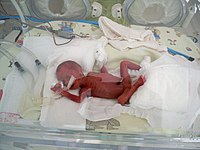
Photo from wikipedia
PurposeThis study aims to understand the clinical characteristics of preterm neonatal necrotizing enterocolitis (NEC) to improve the medical management level.MethodsThe clinical characteristics of preterm NEC infants with low birth weight… Click to show full abstract
PurposeThis study aims to understand the clinical characteristics of preterm neonatal necrotizing enterocolitis (NEC) to improve the medical management level.MethodsThe clinical characteristics of preterm NEC infants with low birth weight (LBW, ≥ 1500 g) and very low birth weight (VLBW, < 1500 g) were compared. Then, clinical information, including demographics, surgical interventions and morbidity, were collected.ResultsA total of 149 preterm NEC infants (60 with VLBW and 89 with LBW) were enrolled. Their median birth weight and gestational age were 1600 g and 31 weeks, respectively. Respiratory support and surfactant therapy were more frequent in VLBW infants (90% vs. 38% and 75% vs. 21.3%) than in LBW infants. In addition, 70.5% of these infants were fed by formula before the NEC occurred. Prematurity-associated morbidities were significantly higher in VLBW infants. Furthermore, 12.8% of all NEC infants died at discharge, and mortality was more prevalent in VLBW infants (21.7% vs. 6.7%). The most frequently received surgeries were enterostomy (n = 58), primary anastomosis (n = 42), and peritoneal drainage (n = 2). Multifocal, localized and pan-intestinal disease occurred in 77.5%, 19.6% and three infants, respectively. Furthermore, postoperative complications occurred more frequently in VLBW infants.ConclusionThe overall mortality was 12.8% for infants who had a larger mean gestational age and birth weight, when compared to that in developed countries. Higher rate of formula feeding might be an important risk factor for NEC development. Furthermore, mortality and morbidities, especially nutrition-associated complications, were more frequent in VLBW infants.
Journal Title: Pediatric Surgery International
Year Published: 2018
Link to full text (if available)
Share on Social Media: Sign Up to like & get
recommendations!